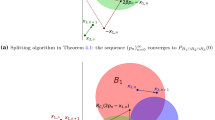Abstract
We propose a flexible approach for computing the resolvent of the sum of weakly monotone operators in real Hilbert spaces. This relies on splitting methods where strong convergence is guaranteed. We also prove linear convergence under Lipschitz continuity assumption. The approach is then applied to computing the proximity operator of the sum of weakly convex functions, and particularly to finding the best approximation to the intersection of convex sets.
Similar content being viewed by others
References
Alwadani, S., Bauschke, H.H., Moursi, W.M., Wang, X.: On the asymptotic behaviour of the Aragón Artacho–Campoy algorithm. Oper. Res. Lett. 46(6), 585–587 (2018)
Aragón Artacho, F.J., Campoy, R.: Computing the resolvent of the sum of maximally monotone operators with the averaged alternating modified reflections algorithm. J. Optim. Theory Appl. (2019)
Bauschke, H.H., Combettes, P.L.: A Dykstra-like algorithm for two monotone operators. Pac. J. Optim. 4(3), 383–391 (2008)
Bauschke, H.H., Combettes, P.L.: Convex Analysis and Monotone Operator Theory in Hilbert Spaces, 2nd edn. Springer, New York (2017)
Combettes, P.L.: Iterative construction of the resolvent of a sum of maximal monotone operators. J. Convex Anal. 16(3), 727–748 (2009)
Dao, M.N., Phan, H.M.: Linear convergence of projection algorithms. Math. Oper. Res. (2018). https://doi.org/10.1287/moor.2018.0942
Dao, M.N., Phan, H.M.: Linear convergence of the generalized Douglas–Rachford algorithm for feasibility problems. J. Glob. Optim. 72(3), 443–474 (2018)
Dao, M.N., Phan, H.M.: Adaptive Douglas–Rachford splitting algorithm for the sum of two operators (2018). arXiv:1809.00761
Douglas, J., Rachford, H.H.: On the numerical solution of heat conduction problems in two and three space variables. Trans. Am. Math. Soc. 82, 421–439 (1956)
Dykstra, R.L.: An algorithm for restricted least squares regression. J. Am. Stat. Assoc. 78(384), 837–842 (1983)
Lions, P.-L., Mercier, B.: Splitting algorithms for the sum of two nonlinear operators. SIAM J. Numer. Anal. 16(6), 964–979 (1979)
Peaceman, D.W., Rachford, H.H.: The numerical solution of parabolic and elliptic differential equations. J. Soc. Ind. Appl. Math. 3, 28–41 (1955)
Acknowledgements
The authors thank two anonymous referees for their careful reading and helpful comments. MND was partially supported by Discovery Project 160101537 from the Australian Research Council. HMP was partially supported by Autodesk, Inc. via a gift made to the Department of Mathematical Sciences, University of Massachusetts Lowell.
Author information
Authors and Affiliations
Corresponding author
Additional information
Publisher's Note
Springer Nature remains neutral with regard to jurisdictional claims in published maps and institutional affiliations.
Rights and permissions
About this article
Cite this article
Dao, M.N., Phan, H.M. Computing the resolvent of the sum of operators with application to best approximation problems. Optim Lett 14, 1193–1205 (2020). https://doi.org/10.1007/s11590-019-01432-x
Received:
Accepted:
Published:
Issue Date:
DOI: https://doi.org/10.1007/s11590-019-01432-x




